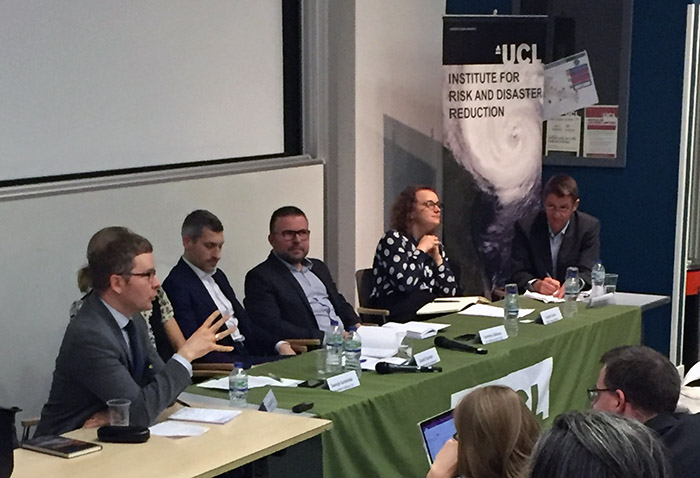DAI and UCL Host Panel on Risk Financing for Disaster Preparedness
March 10, 2017
With the University College of London Institute of Risk and Disaster Reduction, DAI recently held a panel discussion on effective financial planning for disasters, titled “Risk Financing for the Developing World.”
Risk financing seeks to put reliable funding for response efforts in place in advance of a natural disaster, disease outbreak, or other crisis, and is a topic of increasing interest for the international donor community, including the U.K. Department for International Development (DFID). The event supported the broad goals of DFID’s Expert Advisory Call Down Service (EACDS) Lot B: Resilience and Response to Crisis, under which DAI provides rapid-response expertise and advice to DFID and other entities.

Panelists, from left, Daniel Clarke, chair of U.K. Government Actuary Department; Swenja Surminski of the London School of Economics; Daniel Stander of Risk Management Solutions; Carmine Galasso of UCL, Sophie Evans of Willis Towers Watson; and Ric Goodman of DAI.
Risk financing typically utilizes private-sector approaches, including insurance in which financiers commit to a pay out if a crisis occurs in return for receipt of a premium, and bonds that investors can purchase and expect a return as long as no major crisis occurs during the investment term. In contrast, the standard model for funding relief efforts is through appeals for donations after a disaster strikes. Risk financing approaches could enable faster and better planned crisis response, with funding already in place and assured under contract, thereby sparing donor grant funds for other uses.
“We are excited to bring together an amazing panel of leading thinkers and a highly diverse group of participants to look at how we can develop better plans and smarter funding for disaster response,” said Cathy Shaw, Head of EACDS Lot B and DAI’s Know How Lab. “Working collaboratively and breaking down disciplinary boundaries is fundamental to our EACDS service on strengthening resilience, and this is one of many conversations that we hope will support those efforts.”
Experts from the commercial, government, and academic sectors discussed incentives and obstacles to the uptake of risk finance in the developing world. Topics included when and how risk finance approaches can help, and how they relate to risk reduction measures.
The panel emphasized that risk transfer—shifting the financial burden of crisis response—should not replace measures to reduce exposure to the impacts of a disaster, and that these two aspects of disaster preparedness should instead complement each other. Panelists also examined how local and international partners can better collaborate to meet risk-related financial planning needs in the developing world. Reliability in risk finance instruments is critical, they agreed, since failure to pay will destroy trust and place lives and livelihoods at risk.
The discussion was chaired by Daniel Clarke of the Government Actuary’s Department and co-author of Dull Disasters?: How Planning Ahead Will Make a Difference. Panelists included insurance specialists, programme implementers, and disaster risk reduction specialists. DAI’s Ric Goodman, Team Lead for the Kenya Hunger Safety Net Programme, shared how the project uses scalable cash transfers to provide a safety net for some of the poorest and most vulnerable populations in Kenya.
“One of the ways we try to reduce the impact of severe drought is by scaling up coverage of cash transfers to families in northern Kenya as soon as pre-agreed triggers are met,” said Goodman. “Having this cash on hand right away can help families mitigate immediate hardships that can otherwise lead to detrimental coping measures, such as selling off potentially valuable livestock at a low price just to survive.”
The event brought together more than 200 attendees, including representatives from across DFID and other U.K. Government agencies, universities, the insurance industry, and development and humanitarian organizations, including many of DAI’s more than 60 partners on the EACDS Lot B service.
A summary of key takeaways and a podcast of the discussion will be available soon on the DAI Know How Resilience Learning Blog.
RELATED CONTENT:
DAI History: 40 Years of Excellence
DAI was founded in 1970 by three graduates of Harvard University’s Kennedy School of Government intent on providing a more dynamic and effective brand of development assistance. See how DAI is turning this American success story, into a global one.
Read More